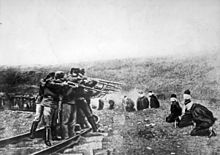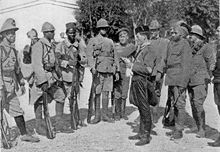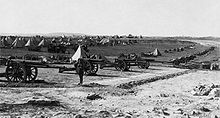War in the Balkans
Faced with Russia, Austria-Hungary could spare only one-third of its army to attack Serbia. After suffering heavy losses, the Austrians briefly occupied the Serbian capital,Belgrade. A Serbian counter attack in the battle of Kolubara, however, succeeded in driving them from the country by the end of 1914. For the first ten months of 1915, Austria-Hungary used most of its military reserves to fight Italy. German and Austro-Hungarian diplomats, however, scored a coup by persuading Bulgaria to join in attacking Serbia. The Austro-Hungarian provinces of Slovenia, Croatia and Bosnia provided troops for Austria-Hungary, invading Serbia as well as fighting Russia and Italy.Montenegro allied itself with Serbia.
Serbia was conquered in a little more than a month. The attack began in October, when the Central Powers launched an offensive from the north; four days later the Bulgarians joined the attack from the east. The Serbian army, fighting on two fronts and facing certain defeat, retreated into Albania, halting only once to make a stand against the Bulgarians. The Serbs suffered defeat near modern day Gnjilane in the Battle of Kosovo. Montenegro covered the Serbian retreat towards the Adriatic coast in the Battle of Mojkovac in 6–7 January 1916, but ultimately the Austrians conquered Montenegro, too. Serbian forces were evacuated by ship to Greece.
In late 1915, a Franco-British force landed at Salonica in Greece, to offer assistance and to pressure the government to declare war against the Central Powers. Unfortunately for the Allies, the pro-German King Constantine I dismissed the pro-Allied government of Eleftherios Venizelos, before the Allied expeditionary force could arrive. The friction between the king of Greece and the Allies continued to accumulate with the National Schism, which effectively divided Greece between regions still loyal to the king and the new provisional government of Venizelos located in Salonica. After intense diplomatic negotiations and an armed confrontation in Athens between Allied and royalist forces (an incident known as Noemvriana) the king of Greece resigned, and his second son Alexander took his place. Venizelos returned to Athens on 29 May 1917 and Greece, now unified, officially joined the war on the side of the Allies. The entire Greek army was mobilized and began to participate in military operations against the Central Powers on the Macedonian front.
After conquest, Serbia was divided between Austro-Hungary and Bulgaria. Bulgarians commenced Bulgarization of the Serbian population in their occupation zone, banishing Serbian Cyrillic and the Serbian Orthodox Church. After forced conscription of the Serbian population into the Bulgarian army in 1917, the Toplica Uprising began. Serbian rebels liberated for a short time the area between the Kopaonik mountains and the South Morava river. The uprising was crushed by joint efforts of Bulgarian and Austrian forces at the end of March 1917.
The Macedonian Front proved static for the most part. Serbian forces retook part of Macedonia by recapturing Bitola on 19 November 1916. Only at the end of the conflict were the Entente powers able to break through, after most of the German and Austro-Hungarian troops had withdrawn. The Bulgarians suffered their only defeat of the war at the Battle of Dobro Pole but days later, they decisively defeated British and Greek forces at the Battle of Doiran, avoiding occupation. Bulgaria signed an armistice on 29 September 1918. Hindenburg and Ludendorff concluded that the strategic and operational balance had now shifted decidedly against the Central Powers and a day after the Bulgarian collapse, during a meeting with government officials, insisted on an immediate peace settlement.
The disappearance of the Macedonian front meant that the road to Budapest and Vienna was now opened for the 670,000-strong army of general Franchet d'Esperey as the Bulgarian capitulation deprived the Central Powers of the 278 infantry battalions and 1,500 guns (the equivalent of some 25 to 30 German divisions) that were previously holding the line. The German high command was able to respond by sending in only seven infantry and one cavalry division but these forces were far from sufficient for a front to be reestablished.
Ottoman Empire
The Ottoman Empire joined the Central Powers in the war, the secret Ottoman-German Alliance having been signed in August 1914. It threatened Russia's Caucasian territories and Britain's communications with India via the Suez Canal. The British and French opened overseas fronts with the Gallipoli (1915) and Mesopotamian campaigns. In Gallipoli, the Ottoman Empire successfully repelled the British, French and Australian and New Zealand Army Corps (ANZACs). In Mesopotamia, by contrast, after the disastrous Siege of Kut (1915–16), British Imperial forces reorganised and captured Baghdad in March 1917. Further to the west, in the Sinai and Palestine Campaign, initial British setbacks were overcome when they captured Jerusalem in December 1917. The Egyptian Expeditionary Force, under Field MarshalEdmund Allenby, broke the Ottoman forces at the Battle of Megiddo in September 1918.
Russian armies generally had the best of it in the Caucasus. Enver Pasha, supreme commander of the Ottoman armed forces, was ambitious and dreamed of re-conquering central Asia, and areas that had been lost to Russia previously. He was, however, a poor commander. He launched an offensive against the Russians in the Caucasus in December 1914 with 100,000 troops; insisting on a frontal attack against mountainous Russian positions in winter, he lost 86% of his force at the Battle of Sarikamish.
General Yudenich, the Russian commander from 1915 to 1916, drove the Turks out of most of the southern Caucasus with a string of victories. In 1917, Russian Grand Duke Nicholas assumed command of the Caucasus front. Nicholas planned a railway from Russian Georgia to the conquered territories, so that fresh supplies could be brought up for a new offensive in 1917. However, in March 1917, (February in the pre-revolutionary Russian calendar), the Czar was overthrown in the February Revolutionand the Russian Caucasus Army began to fall apart.
The army corps of Armenian volunteer units realigned under the command of General Tovmas Nazarbekian, with Dro as a civilian commissioner of the Administration for Western Armenia. The front line had three main divisions commanded by Movses Silikyan, Andranik, and Mikhail Areshian. Another regular unit was under Colonel Korganian. More than 40,000 men in Armenian partisan guerrilla detachments accompanied the main units.
Instigated by the Arab bureau of the British Foreign and Commonwealth Office, the Arab Revolt started with the help of Britain in June 1916 at the Battle of Mecca, led bySherif Hussein of Mecca, and ended with the Ottoman surrender of Damascus. Fakhri Pasha, the Ottoman commander of Medina, resisted for more than two and half years during the Siege of Medina.
Along the border of Italian Libya and British Egypt, the Senussi tribe, incited and armed by the Turks, waged a small-scale guerrilla war against Allied troops. The British were forced to dispatch 12,000 troops to oppose them in the Senussi Campaign. Their rebellion was finally crushed in mid-1916.
Italian participation
Italy had been allied with the German and Austro-Hungarian Empires since 1882 as part of the Triple Alliance. However, the nation had its own designs on Austrian territory in Trentino, Istria and Dalmatia. Rome had a secret 1902 pact with France, effectively nullifying its alliance. At the start of hostilities, Italy refused to commit troops, arguing that the Triple Alliance was defensive in nature, and that Austria–Hungary was an aggressor. The Austro-Hungarian government began negotiations to secure Italian neutrality, offering the French colony of Tunisia in return. The Allies made a counter-offer in which Italy would receive the Southern Tyrol, Julian March and territory on the Dalmatian coast after the defeat of Austria-Hungary. This was formalised by the Treaty of London. Further encouraged by the Allied invasion of Turkey in April 1915, Italy joined the Triple Entente and declared war on Austria-Hungary on 23 May. Fifteen months later Italy declared war on Germany.
Militarily, the Italians had numerical superiority. This advantage, however, was lost, not only because of the difficult terrain in which fighting took place, but also because of the strategies and tactics employed. Field Marshal Luigi Cadorna, a staunch proponent of the frontal assault, had dreams of breaking into the Slovenian plateau, taking Ljubljana and threatening Vienna. It was a Napoleonic plan, which had no realistic chance of success in an age of barbed wire, machine guns, and indirect artillery fire, combined with hilly and mountainous terrain.
On the Trentino front, the Austro-Hungarians took advantage of the mountainous terrain, which favoured the defender. After an initial strategic retreat, the front remained largely unchanged, while Austrian Kaiserschützen and Standschützen engaged Italian Alpini in bitter hand-to-hand combat throughout the summer. The Austro-Hungarians counter attacked in the Altopiano of Asiago, towards Verona and Padua, in the spring of 1916, (Strafexpedition), but made little progress.
Beginning in 1915, the Italians under Cadorna mounted eleven offensives on the Isonzo front along the Isonzo River, north east of Trieste. All eleven offensives were repelled by the Austro-Hungarians, who held the higher ground. In the summer of 1916, the Italians captured the town of Gorizia. After this minor victory, the front remained static for over a year, despite several Italian offensives. In the autumn of 1917, thanks to the improving situation on the Eastern front, the Austro-Hungarian troops received large numbers of reinforcements, including German Stormtroopers and the elite Alpenkorps. The Central Powers launched a crushing offensive on 26 October 1917, spearheaded by the Germans. They achieved a victory at Caporetto. The Italian army was routed and retreated more than 100 kilometres (60 mi.) to reorganise, stabilising the front at the Piave River. Since in the Battle of Caporetto the Italian Army had heavy losses, the Italian Government called to arms the so-called '99 Boys (Ragazzi del '99), that is, all males who were 18 years old. In 1918, the Austro-Hungarians failed to break through, in a series of battles on the Piave River and, finally being decisively defeated in the Battle of Vittorio Veneto in October of that year. Austria-Hungary surrendered in early November 1918.
Romanian participation
Romania had been allied with the Central Powers since 1882. When the war began, however, it declared its neutrality, arguing that because Austria-Hungary had itself declared war on Serbia, Romania was under no obligation to join the war. When the Entente Powers promised Romania large territories of eastern Hungary (Transylvania and Banat), that had a large Romanian population, in exchange for Romania’s declaring war on the Central Powers, the Romanian government renounced its neutrality, and on 27 August 1916 the Romanian Army launched an attack against Austria-Hungary, with limited Russian support. The Romanian offensive was initially successful, pushing back the Austro-Hungarian troops in Transylvania, but a counter attack by the forces of the Central Powers drove back the Russo-Romanian forces and as a result of the Battle of Bucharest the Central Powers occupied Bucharest on 6 December 1916. Fighting in Moldova continued in 1917, resulting in a costly stalemate for the Central Powers. As Russia withdrew from the war in late 1917 as a result of the October Revolution, Romania was forced to sign an armistice with the Central Powers on 9 December 1917.
In January 1918, Romanian forces established control over Bessarabia as the Russian Army abandoned the province. Although a treaty was signed by the Romanian and the Bolshevik Russian government following talks between 5–9 March 1918 on the withdrawal of Romanian forces from Bessarabia within two months, on 27 March 1918 Romania attached Bessarabia to its territory, formally based on a resolution passed by the local assembly of the territory on the unification with Romania.
Romania officially made peace with the Central Powers by signing the Treaty of Bucharest on 7 May 1918. Under that treaty Romania was obliged to cease war with the Central Powers and make small territorial concessions for Austria-Hungary, ceding control of some passes in the Carpathian Mountains and grant oil concessions for Germany. In exchange, the Central Powers recognised the sovereignty of Romania over Bessarabia. The treaty was renounced in October 1918 by the Alexandru Marghiloman government and Romania nominally re-entered the war on 10 November 1918. The next day, the Treaty of Bucharest was nullified by the terms of the Armistice of Compiègne. Total Romanian deaths from 1914 to 1918, military and civilian, within contemporary borders, were estimated at 748,000.
The role of India
The war began with an unprecedented outpouring of loyalty and goodwill towards the United Kingdom from within the mainstream political leadership, contrary to initial British fears of an Indian revolt. TheIndian Army in fact outnumbered the British Army at the beginning of the war. India under British rule contributed greatly to the British war effort by providing men and resources. This was done by the Indian Congress in hope of achieving self-government as India was very much under the control of the British. The United Kingdom disappointed the Indians by not providing self-governance, leading to the Gandhian Era in Indian history. About 1.3 million Indian soldiers and labourers served in Europe, Africa, and the Middle East, while both the Indian government and the princes sent large supplies of food, money, and ammunition. In all 140,000 men served on the Western Front and nearly 700,000 in the Middle East. Casualties of Indian soldiers totalled 47,746 killed and 65,126 wounded during World War I.







No comments:
Post a Comment